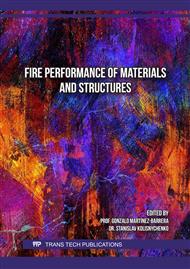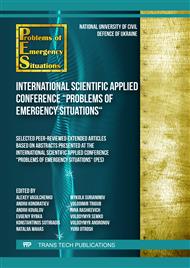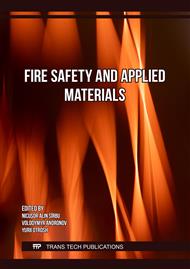[1]
O. Zavialova, M. Grygorian, V. Kostenko, N. Liashok, T. Kostenko, V. Pokaliuk, Theoretical basis for the formation of damaging factors during the coal aerosol explosion, Mining of Mineral Deposits, 15/4 (2021) 130–138.
DOI: 10.33271/mining15.04.130
Google Scholar
[2]
O Kulakov, A. Katunin, Y. Kozhushko, S. Herasymov, O. Roianov, T. Gorbach, Usage of Lidar Systems for Detection of Hazardous Substances in Various Weather Conditions 2020 IEEE Ukrainian Microwave Week, UkrMW 2020 – Proceedings, 9252783 (2020) 360–363.
DOI: 10.1109/ukrmw49653.2020.9252783
Google Scholar
[3]
M. Kustov, V. Kalugin, V. Tutunik, O. Tarakhno, Physicochemical principles of the technology of modified pyrotechnic compositions to reduce the chemical pollution of the atmosphere, Voprosy Khimii i Khimicheskoi Tekhnologii, 1 (2019) 92–99.
DOI: 10.32434/0321-4095-2019-122-1-92-99
Google Scholar
[4]
D. Dubinin, K. Korytchenko, A. Lisnyak, I. Hrytsyna, V. Trigub, Numerical simulation of the creation of a fire fighting barrier using an explosion of a combustible charge, Eastern-European Journal of Enterprise Technologies, 6(10-90) (2017) 11–16.
DOI: 10.15587/1729-4061.2017.114504
Google Scholar
[5]
S. Vambol, V. Vambol, Abees Hmood Al-Khalidy K. Experimental study of the effectiveness of water-air suspension to prevent an explosion, Journal of Physics: Conference Series, 1294/7(2019) 072009.
DOI: 10.1088/1742-6596/1294/7/072009
Google Scholar
[6]
A. Semko, O. Rusanova, O. Kazak, M. Beskrovnaya, S. Vinogradov, I. Gricina, The use of pulsed high-speed liquid jet for putting out gas blow-out, International Journal of Multiphysics, 9/1 (2015) 9–20.
DOI: 10.1260/1750-9548.9.1.9
Google Scholar
[7]
A.N. Semko, M.V. Beskrovnaya, S.A. Vinogradov, I.N. Hritsina, N.I. Yagudina, The usage of high speed impulse liquid jets for putting out gas blowouts, Journal of Theoretical and Applied Mechanics, 52(3) (2014) 655–664.
Google Scholar
[8]
K. Korytchenko, A. Ozerov, D. Vinnikov, Y. Skob, D. Dubinin, R. Meleshchenko, Numerical simulation of influence of the non-equilibrium excitation of molecules on direct detonation initiation by spark discharge, Problems of Atomic Science and Technology,116(4) (2018) 194–199.
DOI: 10.46813/2021-134-171
Google Scholar
[9]
K. Korytchenko, O. Sakun, D. Dubinin, Y. Khilko, E. Slepuzhnikov, A. Nikorchuk, I. Tsebriuk, Experimental investigation of the fire-extinguishing system with a gas-detonation charge for fluid acceleration, Eastern-European Journal of Enterprise Technologies, 3/5(93) (2018) 47–54.
DOI: 10.15587/1729-4061.2018.134193
Google Scholar
[10]
B. Pospelov, V. Andronov, E. Rybka, V. Popov, A. Romin, Experimental study of the fluctuations of gas medium parameters as early signs of fire, Eastern-European Journal of Enterprise Technologies,1(10–91) (2018) 50–55.
DOI: 10.15587/1729-4061.2018.122419
Google Scholar
[11]
B. Pospelov, V. Andronov, E. Rybka, V. Popov, O. Semkiv, Development of the method of frequency-temporal representation of fluctuations of gaseous medium parameters at fire, Eastern-European Journal of Enterprise Technologies, 2/10(92) (2018) 44–49.
DOI: 10.15587/1729-4061.2018.125926
Google Scholar
[12]
V. Andronov, B. Pospelov, E. Rybka, Development of a method to improve the performance speed of maximal fire detectors, Eastern-European Journal of Enterprise Technologies, 2/9(86) (2017) 32–37.
DOI: 10.15587/1729-4061.2017.96694
Google Scholar
[13]
B. Pospelov, V. Andronov, E. Rybka, M. Samoilov, O. Krainiukov, I. Biryukov, T. Butenko, Yu. Bezuhla, K. Karpets, E. Kochanov, Development of the method of operational forecasting of fire in the premises of objects under real conditions, Eastern-European Journal of Enterprise, 2/10(110) (2021) 43–50.
DOI: 10.15587/1729-4061.2021.226692
Google Scholar
[14]
B. Pospelov, V. Andronov, E. Rybka, R. Meleshchenko, S. Gornostal, Analysis of correlation dimensionality of the state of a gas medium at early ignition of materials, Eastern-European Journal of Enterprise Technologies,5(10) (2018) 25–30.
DOI: 10.15587/1729-4061.2018.142995
Google Scholar
[15]
B. Pospelov, V. Andronov, E. Rybka, R. Meleshchenko, P. Borodych, Studying the recurrent diagrams of carbon monoxide concentration at early ignitions in premises, Eastern-European Journal of Enterprise Technologies,3(9–93) (2018) 34–40.
DOI: 10.15587/1729-4061.2018.133127
Google Scholar
[16]
M. Boot, M. Tian, E. Hensen, S. Mani, Impact of fuel molecular structure on autoignition behavior: design rules for future high performance gasolines, Progress in Energy and Combustion Science, 60(2017) 1–25.
DOI: 10.1016/j.pecs.2016.12.001
Google Scholar
[17]
S. Kahwaji, M. White, Organic Phase Change Materials for Thermal Energy Storage: Influence of Molecular Structure on Properties, Molecules, 26 (2021) 6635.
DOI: 10.3390/molecules26216635
Google Scholar
[18]
D. Tregubov, O. Tarakhno, V. Deineka, F. Trehubova, Oscillation and Stepwise of Hydrocarbon Melting Temperatures as a Marker of their Cluster Structure, Solid State Phenomena, 334 (2022) 124–130.
DOI: 10.4028/p-3751s3
Google Scholar
[19]
O. Tarakhno, D. Tregubov, K. Zhernoklev,V. Kovregin, Osnovni polozhennya protsesu horinnya. Vynyknennya protsesu horinnya, NUZZU, Kharkiv, 2020[in Ukrainian].
Google Scholar
[20]
S. Merchant, F. Goldsmith, A. Vandeputte, M. Burke, S. Klippenstein, W. Green, Understanding low-temperature first-stage ignition delay: Propane, Comb. and Flame,162(10) (2015) 3658–3673.
DOI: 10.1016/j.combustflame.2015.07.005
Google Scholar
[21]
I. Glassman, R. Yetter, Combustion, Elsevier, London, 2014.
Google Scholar
[22]
H. Wu, Zh. Hu, X. Dong, S. Zhang, Zh. Cao, Sh. Lin, Numerical Investigation of Negative Temperature Coefficient Effects on Sooting Characteristics in a Laminar Co-flow Diffusion Flame, ACS Omega, 6 (2021) 15156−15167.
DOI: 10.1021/acsomega.1c01397
Google Scholar
[23]
Quickly find chemical information. PubChem. Information on https://pubchem.ncbi.nlm.nih.gov/.
Google Scholar
[24]
D. Tregubov, O. Tarakhno, D. Sokolov, F. Tregubova, The oscillation of n-alkanes characteristic temperatures under the action the cluster structure of substance, Problems of emergency situations, 32 (2020) 14–30 [in Ukrainian].
Google Scholar
[25]
J. Piehl,A. Zyada,L. Bravo,O. Samimi-Abianeh, Review of Oxidation of Gasoline Surrogates and Its Components, Journal of Combustion, 2018 (2018) 1–27.
DOI: 10.1155/2018/8406754
Google Scholar
[26]
M. Reichel,B. Krumm, Yu. Vishnevskiy,S. Blomeyer,J. Schwabedissen, H. Stammler, K. Karaghiosoff, Solid-State and Gas-Phase Structures and Energetic Properties of the Dangerous Methyl and Fluoromethyl Nitrates, Angewandte Chemie International Edition, 58(51)(2019)18557–18561.
DOI: 10.1002/anie.201911300
Google Scholar
[27]
Yu. Hapon, D. Tregubov, E. Slepuzhnikov, V. Lypovyi, Cluster Structure Control of Coatings by Electrochemical Coprecipitation of Metals to Obtain Target Technological Properties, Solid State Phenomena, 334 (2022) 70–76.
DOI: 10.4028/p-4ws8gz
Google Scholar
[28]
D. Tregubov, A. Sharshanov, D. Sokolov, F. Tregubova, Forecasting the smallest supramolecular formations for alkanes of normal and isomeric structure, Problems of emergency situations,35 (2022) 63–75[in Ukrainian].
DOI: 10.52363/2524-0226-2022-35-5
Google Scholar
[29]
B. Pospelov, E. Rybka, R. Meleshchenko, S. Gornostal, S. Shcherbak, Results of experimental research into correlations between hazardous factors of ignition of materials in premises. Eastern-European Journal of Enterprise Technologies,6(10–90) (2017) 50–56.
DOI: 10.15587/1729-4061.2017.117789
Google Scholar
[30]
R. Meyer, J. Köhler, A. Homberg, Explosives, Wiley-VCH, Weinheim, 2016.
Google Scholar




